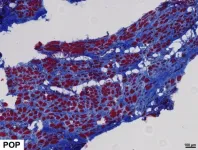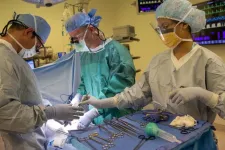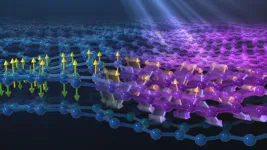(Press-News.org) In the August 02, 2023 issue of Science Translational Medicine, University of California San Diego researchers lead a team that has published new insights on pelvic floor muscle (PFM) dysfunction, which is one of the key risk factors for pelvic floor disorders, a set of morbid conditions that include pelvic organ prolapse and urinary and fecal incontinence, that impact close to a quarter of women in the U.S. and have a strong association with vaginal childbirth. The work is part of a larger effort to advance understanding, treatment and prevention of pelvic floor muscle dysfunction in humans.
The big collaborative question the team is making progress on is the following:
As bioengineers, clinicians, and basic scientists working together, can we move the needle when it comes to reducing damage to the female pelvic floor that occurs during vaginal childbirth?
In the short term, the UC San Diego team has just published new findings that advance this big challenge, though much work is still required. Below is a summary of the key findings published in the August 02, 2023 issue of the journal Science Translational Medicine?
First, new tissue-level research demonstrates that for cis-women who have given birth vaginally and have symptoms of pelvic organ prolapse, their pelvic floor muscles show the damage signs of atrophy and fibrosis (which includes the excess buildup of collagen). This new direct evidence of both atrophy and fibrosis in the skeletal muscles of the pelvic floor of women with symptoms of pelvic organ prolapse is an important step toward developing strategies to either prevent damage or aid recovery after damage occurs. This tissue-level research included samples from age-matched human cadavers as well as women undergoing surgery for pelvic organ prolapse.
Next, the team showed that in a well-established rat model for vaginal birth injury in humans, the pelvic floor muscles of the female rats sustained the same kinds of negative muscle transformations – atrophy and fibrosis – seen in the pelvic floor muscle biopsies of the women (referenced in point one) who have given birth and went on to develop pelvic floor prolapse. This finding serves to validate that additional research using this rat model of birth injury will be relevant for understanding and potentially finding better ways to treat or even prevent pelvic floor dysfunction and the associated pelvic floor disorders in women.
Finally, the team showed that a tissue-specific cell-free pro-regenerative biomaterial, similar to the material invented at UC San Diego that is currently in clinical trials for helping to improve healing of heart tissue after heart attack, could serve as a new approach for helping to prevent or heal pelvic floor muscles injured during childbirth. In particular, the UC San Diego team treated rats subjected to simulated birth injuries with an acellular injectable skeletal muscle extracellular matrix (ECM) hydrogel either at the time of or four weeks after simulated birth injury. They found that the administration of the hydrogel reduced the negative impact of the simulated birth injury on the rat pelvic floor muscles. This new work highlights the need for further investigations of this promising biomaterial for the prevention of pelvic floor muscle dysfunction after birth injury.
Comment from first author Pamela Duran on the implications of this preclinical research:
“Understanding the natural pelvic floor muscle response after birth injury is crucial for developing and applying regenerative medicine approaches. Based on this, we first investigated the pelvic skeletal muscles' short- and long-term responses after birth injury using a rat preclinical model. With these findings, we rationalized applying a cell-free biomaterial to prevent and treat the pathological changes of the pelvic floor muscle after simulated birth injury. The use of a low-cost and minimally invasive biomaterial is crucial for the clinical translation of this regenerative medicine approach to counteract the negative alterations of the pelvic floor muscles,” said Pamela Duran, PhD, the first author on the paper who recently completed her PhD in bioengineering at the University of California San Diego Jacobs School of Engineering. Duran is currently a postdoctoral researcher at the University of Michigan.
Comment from corresponding author Karen L. Christman, who is a bioengineering professor and co-creator of the hydrogel used in this study, on the implications of this preclinical research:
“Current clinical and preclinical strategies for treating damaged pelvic floor muscles have focused on late stage treatments that are suboptimal for patients and do not address the underlying causes of muscle damage. In this preclinical research, we have shown that injecting a hydrogel directly into muscle tissue of the pelvic floor offers a potential method for encouraging and accelerating the natural healing process. In particular, we see the possibility of muscle fiber restoration rather than the unhealthy buildup of collagen,” said Karen L. Christman, a professor in the Shu Chien-Gene Lay Department of Bioengineering at the UC San Diego Jacobs School of Engineering. Christman is also the Associate Dean for Faculty Affairs and Welfare at the UC San Diego Jacobs School of Engineering, where she holds the Pierre Galletti Endowed Chair for Bioengineering Innovation. Professor Christman is a cofounder, consultant, board member, and holds equity interest in Ventrix Bio Inc. and Kairos Technologies Inc. These two companies are working to translate biomaterial technologies into the clinic for applications including efforts to encourage regeneration of heart tissue and improved heart functionality after a heart attack, and prevent adhesions after cardiothoracic surgery. Learn more: This Injectable Biomaterial Heals Tissues from the Inside Out.
Comment from corresponding author Marianna Alperin who is a practicing physician-scientist on the implications of this preclinical research:
“Pelvic skeletal muscles’ birth injury and subsequent degeneration is a key risk factor for pelvic floor disorders that negatively impact lives on millions of women worldwide. Unfortunately, we know very little about tissue-level changes that take place in these important muscles as a result of maternal birth injury. The findings of our study are important because without understanding what goes wrong in pelvic floor muscles, we can’t develop effective strategies to treat these important components of the pelvic floor. As a result, currently available preventative or therapeutic strategies are extremely limited and do not include regenerative approaches. While cell-based therapies are promising in many areas of medicine, they are associated with many hurdles, including substantial costs. In contrast, the biomaterial tested in our study does not contain any cells and is therefore very safe and is low-cost. Investigating what goes wrong in the pelvic skeletal muscles and developing pragmatic approaches to overcome these negative changes is very important for improving women’s health,” said Marianna Alperin, M.D., M.S.
Professor of Obstetrics, Gynecology, and Reproductive Sciences, Professor of Urology, and Fellowship Research Director in the Division of Urogynecology & Pelvic Reconstructive Surgery at University of California San Diego. Dr. Alperin is also affiliated with the Sanford Consortium for Regenerative Medicine.
Funding
Funding for this work was provided by the NIH/NICHD [R21HD094566 (M.A. and K.L.C.), R01HD092515 (M.A.), R01HD102184 (M.A. and K.L.C.)], Galvanizing Engineering in Medicine award supported by the NIH grant UL1TR001442 of CTSA and by funds provided by the University of California San Diego Chancellor. P.D. was supported through the NIAMS T32 Predoctoral Training Grant (T32AR060712) and an NIH/NICHD F31 Predoctoral fellowship (F31HD098007). L.B. received support from June Allyson Memorial Fund Research Award, American Urogynecologic Society and Ellis Wyer Foundation Grant, University of California San Diego, Division of Female Pelvic Medicine and Reconstructive Surgery.
Competing interests information
Karen L. Christman, Marianna Alperin, and Pamela Duran are inventors on a patent (US11376346B2, Extracellular Matrix for Treating Pelvic Floor Disorders and Skeletal Muscle Degeneration) related to this work.
Karen L. Christman is a cofounder, consultant, board member, and holds equity interest in Ventrix Bio Inc. and Kairos Technologies Inc,. and is a consultant for Coloplast. Christman reports an editorial stipend from npj Regenerative Medicine.
Marianna Alperin reports an editorial stipend from American Journal of Obstetrics and Gynecology.
END
New insights on pelvic floor damage after vaginal birth, and new directions for treatment
New insights on pelvic floor muscle (PFM) dysfunction, which is one of the key risk factors for pelvic floor disorders that impact close to a quarter of women in the U.S. and have a strong association with vaginal childbirth.
2023-08-02
ELSE PRESS RELEASES FROM THIS DATE:
Humans unable to detect over a quarter of deepfake speech samples
2023-08-02
The study, published today in PLOS ONE, is the first to assess human ability to detect artificially generated speech in a language other than English.
Deepfakes are synthetic media intended to resemble a real person’s voice or appearance. They fall under the category of generative artificial intelligence (AI), a type of machine learning (ML) that trains an algorithm to learn the patterns and characteristics of a dataset, such as video or audio of a real person, so that it can reproduce original sound or imagery.
While early deepfake speech algorithms may have required thousands of samples of a person’s voice to be able ...
Study exposes plight of deported noncitizen veterans
2023-08-02
RIVERSIDE, Calif. -- A study examining the effects of deportation on the health and wellbeing of noncitizen veterans who served in the United States military has found that this group is a vulnerable and often unrecognized health disparity population.
Overseen by Ann Cheney, an associate professor of social medicine, population, and public health in the School of Medicine at the University of California, Riverside, the study reports the post-deportation economic, social, and political conditions of living abroad harm veterans’ physical and ...
Lockdowns create global appetite for feeding feathered friends
2023-08-02
A team of researchers have highlighted the role that the COVID-19 pandemic played in connecting people around the world more with our feathered friends while in lockdowns, finding a surge in interest for bird feeding information and providing more insight into global human-birds interactions.
Professor Emeritus Darryl Jones, from Griffith’s Centre for Planetary Health and Food Security, and the research team used Google search index (a valid proxy parameter from Google Trends data) and found a surge of interest in bird feeding in 115 countries after Covid-19 led to lockdowns where people stayed home.
Professor Jones, alongside lead author Associate Professor ...
Researchers discover a novel pathway that minimizes liver injury during transplantation
2023-08-02
UCLA-led research describes the role that a protein called CEACAM1 plays in protecting the liver from injury during the transplantation process, potentially improving transplant outcomes. But the features that regulate this protective characteristic remain unknown.
In a new study, to be published online Aug. 2 in Science Translational Medicine, a research team has identified the molecular factors at the root of this protection and shown how using molecular tools and alternative gene splicing can make CEACAM1 more protective, thus reducing organ injury and ultimately improving post-transplant outcomes.
Prior to transplantation, a solid organ, such as a liver, has no ...
UIC leads field study on home, water safety after Ohio chemical spill
2023-08-02
In February, the train derailment and subsequent chemical spill and fires in East Palestine, Ohio, caused an environmental emergency that led thousands of people to evacuate their homes. A multi-university study led by the University of Illinois Chicago will investigate the aftermath of that disaster, collecting data on the experiences of nearby residents and the effectiveness of communication from authorities about water, soil and air quality.
For the study, the researchers will conduct surveys and interviews with residents in and near East Palestine, including counties ...
MD Anderson research highlights for August 2, 2023
2023-08-02
HOUSTON ― The University of Texas MD Anderson Cancer Center’s Research Highlights showcases the latest breakthroughs in cancer care, research and prevention. These advances are made possible through seamless collaboration between MD Anderson’s world-leading clinicians and scientists, bringing discoveries from the lab to the clinic and back.
Recent developments include a novel biomarker that may predict the aggressiveness of pancreatic cancer precursors, insights into the structure and function of a breast and ovarian cancer susceptibility gene, a new approach to overcoming treatment resistance in ovarian cancer, distinguishing features of young-onset ...
August issues of American Psychiatric Association journals cover alcohol use disorder, interventions for PTSD and psychedelics in psychiatry
2023-08-02
The latest issues of three of the American Psychiatric Association’s journals, The American Journal of Psychiatry, Psychiatric Services and Focus are now available online.
The August issue of The American Journal of Psychiatry on the neurodevelopmental origins of psychopathology is focused on early-life adversity and genetics as mediators of the risk to develop psychiatric illnesses. Highlights include:
Overview of Alcohol Use Disorder.
A Comprehensive Multilevel Analysis of the Bucharest Early Intervention Project: Causal Effects on Recovery from Early Severe Deprivation. ...
Eyewitnesses to Arctic Change
2023-08-02
On Thursday, 3 August 2023, the research vessel Polarstern is scheduled to set off from Tromsø, Norway, towards the North Pole. For two months, a good fifty scientific expedition participants will explore the Arctic in transition as sea ice extent reaches its annual minimum in September. They will explore the biology, chemistry and physics of sea ice as well as the effects of sea ice retreat on the entire ocean system from the surface to the deep sea. Eleven years ago, Antje Boetius was part of the largest ever sea ice minumum in the Arctic ...
New neuroimaging approach could improve diagnosis of schizophrenia
2023-08-02
ATLANTA — New research led by scientists working with Georgia State University’s TReNDS Center has identified age-related changes in brain patterns associated with the risk for developing schizophrenia.
The discovery could help clinicians identify the risk for developing mental illness earlier and improve treatment options. The study is published in the Proceedings of the National Academy of Sciences (PNAS).
The research is part of a collaboration by experts from the University of Bari Aldo Moro, the Lieber Institute of Brain Development and the Tri-institutional Center for Translational Research in ...
Scientists discover unusual ultrafast motion in layered magnetic materials
2023-08-02
A common metal paper clip will stick to a magnet. Scientists classify such iron-containing materials as ferromagnets. A little over a century ago, physicists Albert Einstein and Wander de Haas reported a surprising effect with a ferromagnet. If you suspend an iron cylinder from a wire and expose it to a magnetic field, it will start rotating if you simply reverse the direction of the magnetic field.
“Einstein and de Haas’s experiment is almost like a magic show,” said Haidan Wen, a ...
LAST 30 PRESS RELEASES:
Injectable breast ‘implant’ offers alternative to traditional surgeries
Neuroscientists devise formulas to measure multilingualism
New prostate cancer trial seeks to reduce toxicity without sacrificing efficacy
Geometry shapes life
A CRISPR screen reveals many previously unrecognized genes required for brain development and a new neurodevelopmental disorder
Hot flush treatment has anti-breast cancer activity, study finds
Securing AI systems against growing cybersecurity threats
Longest observation of an active solar region
Why nail-biting, procrastination and other self-sabotaging behaviors are rooted in survival instincts
Regional variations in mechanical properties of porcine leptomeninges
Artificial empathy in therapy and healthcare: advancements in interpersonal interaction technologies
Why some brains switch gears more efficiently than others
UVA’s Jundong Li wins ICDM’S 2025 Tao Li Award for data mining, machine learning
UVA’s low-power, high-performance computer power player Mircea Stan earns National Academy of Inventors fellowship
Not playing by the rules: USU researcher explores filamentous algae dynamics in rivers
Do our body clocks influence our risk of dementia?
Anthropologists offer new evidence of bipedalism in long-debated fossil discovery
Safer receipt paper from wood
Dosage-sensitive genes suggest no whole-genome duplications in ancestral angiosperm
First ancient human herpesvirus genomes document their deep history with humans
Why Some Bacteria Survive Antibiotics and How to Stop Them - New study reveals that bacteria can survive antibiotic treatment through two fundamentally different “shutdown modes”
UCLA study links scar healing to dangerous placenta condition
CHANGE-seq-BE finds off-target changes in the genome from base editors
The Journal of Nuclear Medicine Ahead-of-Print Tip Sheet: January 2, 2026
Delayed or absent first dose of measles, mumps, and rubella vaccination
Trends in US preterm birth rates by household income and race and ethnicity
Study identifies potential biomarker linked to progression and brain inflammation in multiple sclerosis
Many mothers in Norway do not show up for postnatal check-ups
Researchers want to find out why quick clay is so unstable
Superradiant spins show teamwork at the quantum scale
[Press-News.org] New insights on pelvic floor damage after vaginal birth, and new directions for treatmentNew insights on pelvic floor muscle (PFM) dysfunction, which is one of the key risk factors for pelvic floor disorders that impact close to a quarter of women in the U.S. and have a strong association with vaginal childbirth.





